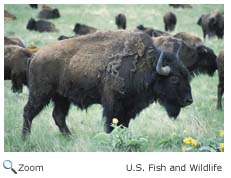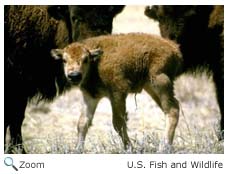Female bison are ready to mate when they are two to three years old. Males aren't ready to mate until they are about six. Mating season begins in July and can run through September. When mating season begins, male bison move into female groups and select a female. They then "tend" the female.

Males tend a female by staying between her and the rest of the herd. Tending can last for a few minutes or for several days. If a female isn't interested in a male, she will walk away. Males will threaten and sometimes attack other males that try to get too close to a female he is tending.
Fights between males can involve headbutting, shoving, or locking horns.

The
female gives birth to one calf after about nine months. She will go to an isolated area to give birth. Newborn bison are reddish-brown and can stand shortly after birth. The mother and her calf will stay isolated from the herd for a couple of days. At about two months, the calf will begin to develop shoulder humps and horns. The calf is usually weaned by the time it is seven months old.
The American bison spends the warm hours of the day resting, chewing its cud or wallowing in dirt. It is most active in the early morning and late afternoon.
Bison live in a variety of groups. Females and young males may live in groups of up to 20 bison. Males also can live in groups of up to 20 males, or they can live in smaller groups or individually. Mature males and females usually live apart except during breeding season. Each bison group has a dominant male or female.